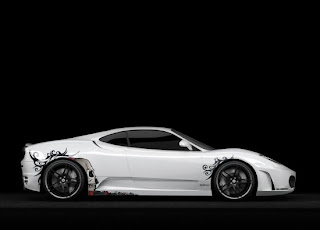The Ferrari F430 is on its way out, making way for its replacement tipped to debut at the Frankfurt show. Ferrari itself is saying goodbye with a special edition to be auctioned off for charity, but a pair of German firms has collaborated to send off the F430 in its own unique brand of style. A joint effort by a company called Unique Sportscars and the Novitec Rosso tuning house we've come to know for its turbo- and supercharged Prancing Horses, the F430 Calavera seems to answer questions nobody was asking, namely, what would a Ferrari look like if it spent too much time on Venice Beach? Well here you have it.
Ferrari F430 Calavera comes with an airbrushed exterior prominently boasts a large skull on the hood, darkened taillights, tinted windows, and 20-inch wheels. The interior also gets a modest makeover with embroidered seats, an elongated center console, and iPod connectivity. The Calavera is powered by a twin-supercharged version of Ferrari’s 4.3-liter V8 engine which produces 707 horsepower and 712 Nm of torque. The Ferrari F430 Calavera rockets from 0-100 km/h in 3.5 seconds before hitting a top speed of 348 km/h (216 mph). Unique Sportcars Ferrari F430 Calavera also comes with other performance kits include a Novitec Rosso front spoiler and rear wing, revised gear ratios, and a lowered sports suspension.
Ferrari F430 Calavera comes with an airbrushed exterior prominently boasts a large skull on the hood, darkened taillights, tinted windows, and 20-inch wheels. The interior also gets a modest makeover with embroidered seats, an elongated center console, and iPod connectivity. The Calavera is powered by a twin-supercharged version of Ferrari’s 4.3-liter V8 engine which produces 707 horsepower and 712 Nm of torque. The Ferrari F430 Calavera rockets from 0-100 km/h in 3.5 seconds before hitting a top speed of 348 km/h (216 mph). Unique Sportcars Ferrari F430 Calavera also comes with other performance kits include a Novitec Rosso front spoiler and rear wing, revised gear ratios, and a lowered sports suspension.















